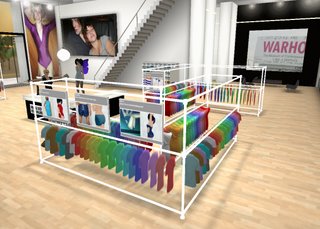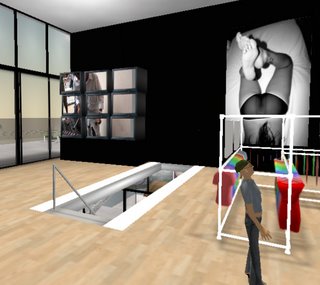part
1 |
2 |
3 | 4 |
5
Ansible Berkman: Susi?
Susi Spicoli: Do you think that we will go beyond traditional marketing: participation in product development, open-source like, which makes traditional marketing obsolete to some extent because consumers are designing their own products? For example, a bank might design (with users)/test their future offering incl branch lay-out, which then already will have a strong in-world following which will spill into the RL. Finally, you might get some great international ideas fertilization (easy in SL), what if Italian customers would give comments and ideas on American Apparel?
Glitchy Gumshoe: Yeah, has any one company (besides the defeat george bush guy) ever tried to market anything to the entire SL population?
SNOOPYbrown Zamboni: I'm interested in sl as a test bed for rl products/creations.
Csven Concord: I think we'll see some of that happen. There's a recent entry on the Mass Customization blog that gets to some things being tried in Europe but I think that most people aren't aware of how much tedious stuff goes into products and so there will always be some "professional" stuff that isn't really done in a collaborative way but mostly because no one wants to do it!
Susi Spicoli: That's what people said before Linux and the success of open source.
Csven Concord: The difference between Linux and designing the boring, legally necessary font on an iron are a ways apart, imo.
SNOOPYbrown Zamboni: Coming up on the xbox 360, as I understand it, you'll be able to design your Nike sneakers in a basketball game using the id system, then have a real pair shipped to you.
Csven Concord: I have a source at Nike. And when they first introduced their shoes in NBA 2k6, the word was that it would be linked - eventually - to the website not seen it yet, but I expect it'll soon happen.
SNOOPYbrown Zamboni: Stylehive has some of that, virtual-real coupling of merchandise.
Hempman Richard: That goes back to my hobby horse: does the fact that we're avatars allow US to try stuff out that we might not try in rl? And get used to it and then buy the product in rl?
SNOOPYbrown Zamboni: I love your idea that avatars double the consumer but... you can also have multiple avs all trying out different avenues of self expression.
Razor Rinkitink: We have certainly talked about trying things in SL that would be difficult to test in RL. Store layouts and even clothing concepts would be interesting to test. But it would be important to remember that the SL audience is rather different from the RL at-large. So how much of that could feed back into RL is not clear.
Fizik Baskerville: We're working with a lot of our clients in SL doing exactly that, Raz.
SNOOPYbrown Zamboni: But when you are using sl to model, it doesn't matter who's here now, right? You just use it to sketch and design and then show it to ppl, in sl or out.
Hamlet Au: The challenge with testing real life designs is presenting it in a way that's fun, a kind of game. Otherwise, people will get bored and fly (literally!) off in search of something that is fun.
SNOOPYbrown Zamboni: Yes and no, Hamlet. It depends on if they're shopping for their real life selves, in which case they're going to want things that would, erm, "fly" in the real world and a realistic avatar to boot. One thing I'm very interested in is the recreation of real life in VWs.
SNOOPYbrown Zamboni: An avatar that reflects your appearance, when you want that for dating, trying things on, doing business, etc.
Hamlet Au: I dunno, SNOOP, I think even then the constraints (or freedoms) of the world will impose themselves. For example, has anyone here ever tried walking, just walking, through an SL building? It gets frustrating. You get stuck in doorways. You eventually just want to fly or teleport to wherever you were headed, most times.
SNOOPYbrown Zamboni: That's because sl is limited atm lol. Have you driven down the streets of Grand Theft Auto? Runs like a breeze. Oh, and of course p2p teleport, but it'll get easier to run around
Ansible Berkman: You're ok running in SL too, as long as the building space is large enough. maybe it's a matter of better designing the space.
Ansible Berkman: If no one else wants to add here, Jangles...your question please?
Jangles Junot: Thanks, Ansible. This is quite an experience. So a question for Razor... If you could buy apparel in the AA store here and get it in the real world, that would be interesting... is that in your thinking? I'm thinking of the impulse. you see something here and you want to buy it... so you order here rather than go to a browser and go to the website.
Razor Rinkitink: It could go that way, but I'm not sure that a buying experience in SL connected to RL is ideal. I'm expecting that people will be curious enough to go out and see our stores and our online store for those types of transactions. But it makes sense to build a smooth transition.
SNOOPYbrown Zamboni: And razor, please please please get some posters of sexy avs up in rl aa stores and advertising ;)
Jangles Junot: Yes, i'm thinking of that relationship, another facet to building it.
Razor Rinkitink: I really do like that idea.
Cristiano Midnight: It appears that the main grid has been attacked and the system may be taken down, so this island may go down as well soon.
SNOOPYbrown Zamboni: To the bat cave!
Csven Concord: *gets camera out*
Ansible Berkman: Until we're taken offline, let's proceed as planed.
Razor Rinkitink: Before the world ends... anyone who feels like checking out our RL store, please visit: http://store.americanapparel.net ... and while you're at it, pop in the promo code BERKMAN and you'll get 15% off for the next couple of days.
Komuso Tokugawa: Now, that's marketing to avatars!
Hamlet Au: It's worth noting that grid-attacks like this are relatively rare but definitely worth considering in relation to how you create your marketing experience.
Gideon Television: I think rl/sl purchase linking in the other direction is more likely - I buy an AA clothing article in RL and then can wear it in SL too.
Razor Rinkitink: AA will do a discount in July off any item purchased SL... on that same item in RL. Going the other way is more... complicated. But could be done.
part
1 |
2 |
3 | 4 |
5










